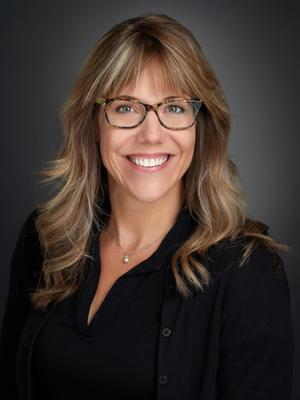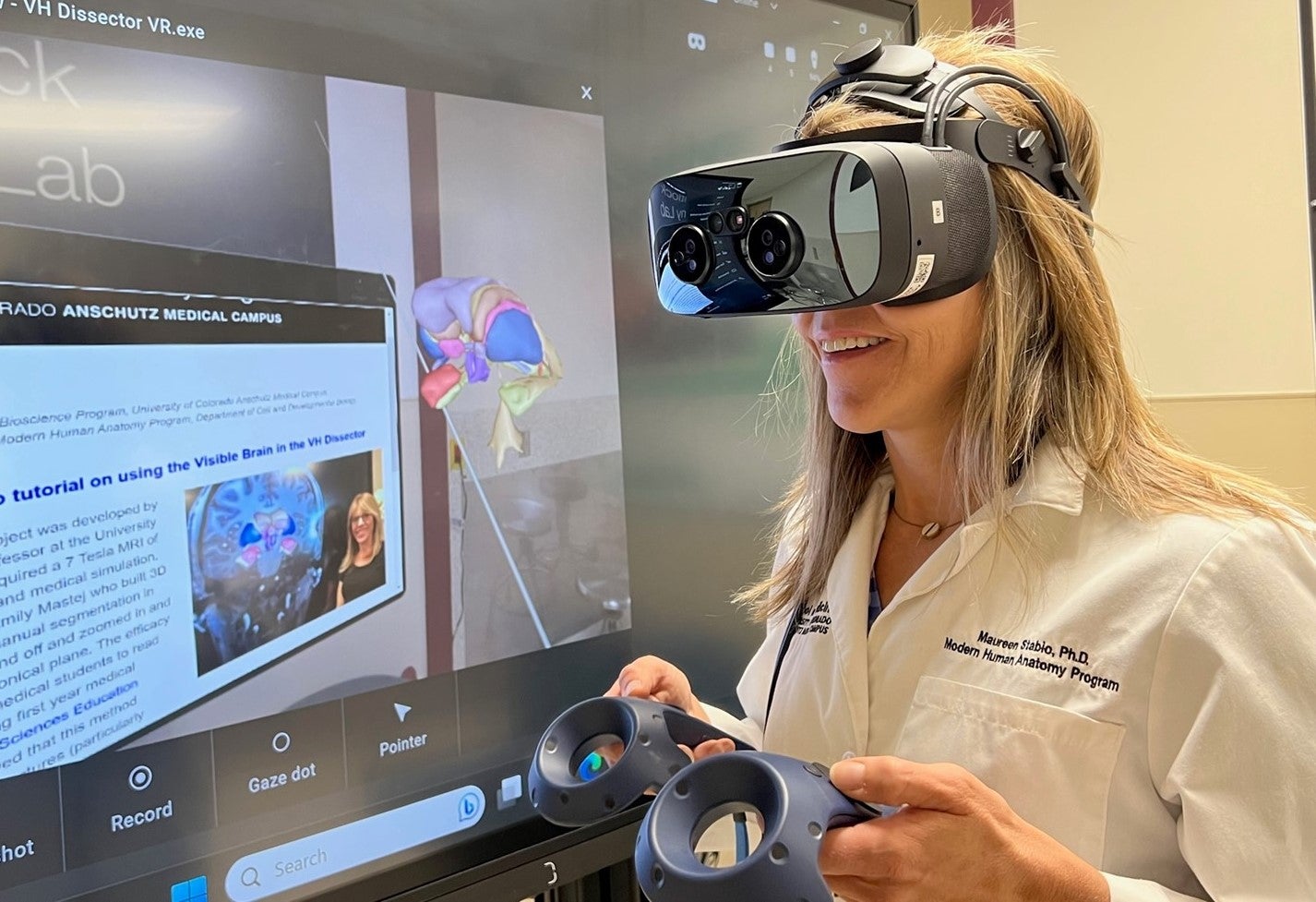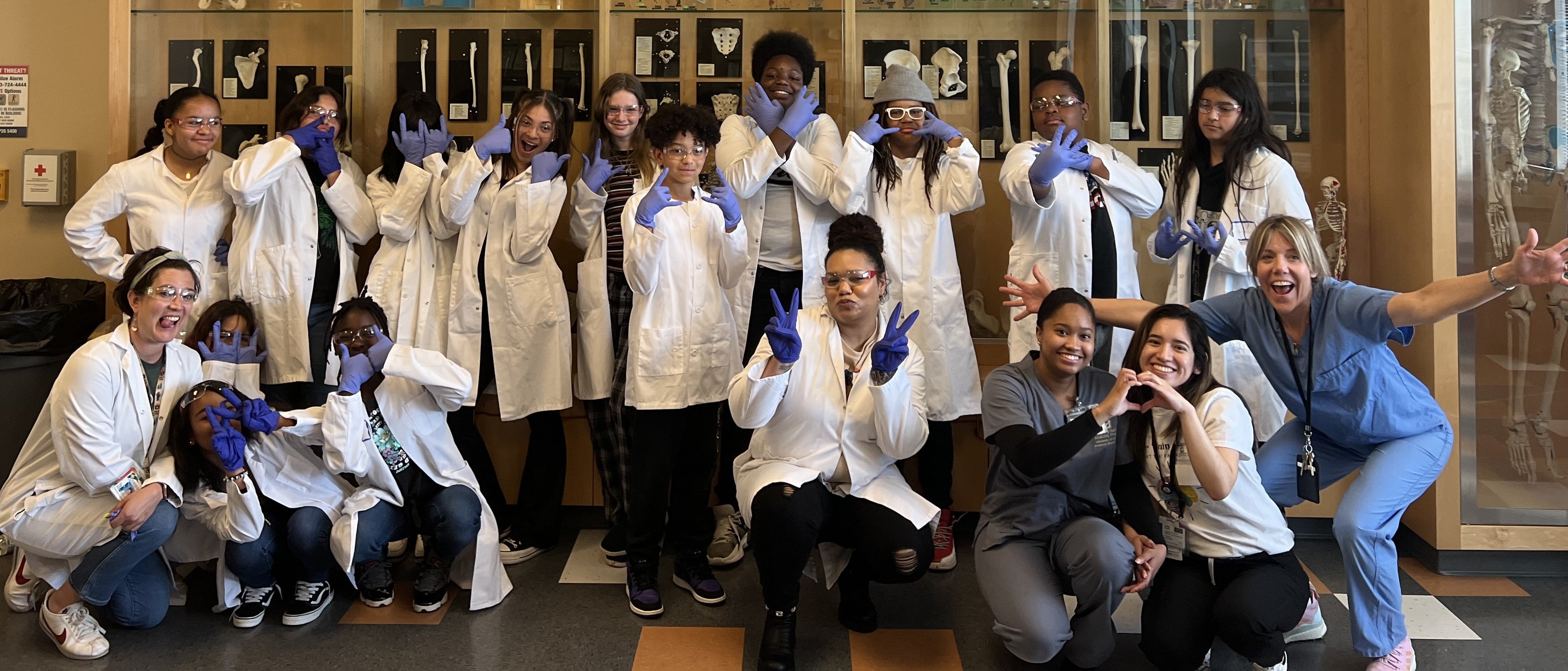Five questions for Maureen Stabio
Maureen Stabio’s interest in anatomy and medicine was sparked in high school. She credits her high school anatomy teacher – Ms. Skibo, now Mrs. Moore – with first stoking that interest.

“Then, I received a once-in-a-lifetime opportunity through a family connection to observe a cardiovascular surgery and see a real human heart,” Stabio said. “I remember so vividly the moment I saw that amazing and beautiful human heart beating in the body of a patient under the careful hands of the physician. I was awestruck, and I wanted more. From there, my love of human anatomy was born, and the pursuit of higher education followed.”
Stabio’s early interest in cardiology took a detour after she took her first neuroscience course, “and my mind was even more blown by the complexity and mystery of the brain.”Today, 20 years later, Stabio is an associate professor of neuroanatomy in the Modern Human Anatomy Program at the CU Anschutz Medical Campus. She directs the neuroscience curriculum for the CU School of Medicine.
Stabio recently received funding through the Timmerhaus Fund Ambassadors to boost her Experience Anatomy initiative, an interactive anatomy learning lab of plastinated human organs, as well as virtual dissection using augmented reality technology at CU Anschutz. With four events she’s planning for the current school year, Stabio aims to reach hundreds of teens across the Denver area.
“I want to provide a transformative, hands-on, interactive experience for the youth of Colorado who may not be as fortunate as I was that special day my sophomore year of high school when I saw the human heart,” she said.
1. How did the idea for Experience Anatomy come about, and how will the Timmerhaus Ambassadors funding help?
Klaus Timmerhaus’ mission was to promote public understanding of the value of education in Colorado and beyond. When I read about the Timmerhaus Ambassador program, I thought that there is no better way to get the public excited and engaged in learning than to hold, touch, feel and experience it themselves. And we can do that with anatomy.
My interest in outreach grew in 2016, when I started plastinating human brains. I inherited the WeLL-COMe (Wellness, Lifelong Learning and Career Orientation Mentorship) program, where middle school students can come in and hold brains. With middle school students, I’m planting a seed. With high school students, I hope to get them excited about the idea of higher education.
2. What’s the nature of the Experience Anatomy events you’re planning for this school year?
Experience Anatomy is an interactive anatomy learning lab that provides students an immersive hands-on experience with anatomy. Students hold real human organs, learn about organ transplant technology, and virtually dissect a human brain in virtual reality (VR). VR is something I’m adding that’s new this year. I personally don’t love VR, because I’m not a high-tech person. But I saw the value of VR in breaking through to a kid whose only interest is videogames. I’m trying to use the love language of that generation to get them interested in science.
We piloted two programs over the summer, trying out various lesson plans, and we have multiple Saturday day camps scheduled for high schoolers this fall. We have an official program on Oct. 21 that we’re doing in collaboration with the CU Pre-Health Scholars Program; they have a high school academy. We also have a girls’ camp Nov. 4. I have about four more schools I’m reaching out to. (High school educators who are interested can contact Stabio at maureen.stabio@cuanschutz.edu.)
3. Tell me about other STEM outreach volunteer work you do with high schools. Why is such outreach important?
Beyond just the intrinsic value of sharing the importance of science with the next generation, on a deeper level, outreach is critical for our society. Our modern culture has unfortunately embraced an ethos centered around expressive individualism and self-actualization. The constant focus on self, paired with one’s subjective feelings about self (that is either helped or hurt by social media) has created a narcissistic and discontented society.
The antidote? Service. Serving others gets the focus off “me and my needs” and moves the focus to others and their needs. Communities that serve others together, grow stronger together.
The greatest reward I have in doing outreach is seeing the impact it has on my graduate students who volunteer. This is why a core component of all of my outreach efforts is the involvement of graduate students who work in teams together to teach and serve. Some of my former graduate student leaders have gone on to lead other programs in their communities based on the positive experiences they’ve had in service projects at CU Anschutz.
When I’m doing outreach, some kids say to me, ‘I can’t afford higher education, it’s impossible to pay for.’ So we had two graduate students talk about their strategy for paying for higher education – every pathway out there. So we’ll do that again.
4. Last year, you were the CU Anschutz recipient of the Open Educational Resources (OER) Champion Award from the CU system. What was your project?

We’re working on digitization of the CU Plastinated Organ Library. I started out with one plastinated brain and we now have more than 50 physical specimens.
When I was taking anatomy in high school, in 1994, that was when Vic Spitzer published the Visible Human. My parents got me a coffee table book of pictures from the Visible Human Project. I never imagined I’d get to work with Dr. Spitzer, and now I’m creating the Visible Brain. It will be a chapter in the Visible Human software program.
5. How has teaching and research in modern human anatomy evolved since you first entered the field?
As you can imagine, there are not a lot of new discoveries in anatomy. What’s really evolving is the marriage between animation, imaging, modeling and medicine, such as the use of 3D printing for surgical planning via CU’s Inworks program, and the use of 3D animation for patient education.
The use of immersive, real-time, 3D technology in anatomy is exploding. The modern anatomist must not only be a master of classical anatomy but also be fluent in 3D virtual anatomy. Advancements in medical imaging, machine learning-driven segmentation, surface scanning and 3D printing have made it crucial for modern anatomists to be cross-trained in classical anatomy and digital cadaver preservation.
However, most graduate anatomy education programs lack formal instruction in 3D technology. To address this gap, in 2022, with the support of an Epic Mega Grant, we established the Anatomical Imaging and Modeling (AIM) track within the Modern Human Anatomy Master’s Program at CU. Our presentation focuses on our training framework for students in industry-standard software, the development of independent research skills, and the achievements and experiences of our students.
I feel so lucky to have a job where I get to work on all these fun projects with students who are really excited.


